
Kuştul Monastery was a Greek Orthodox monastery, located near Şimşirli village, Maçka district, Trabzon Province, Turkey. The native name is sometimes also shortened to Peristera.
Lunxhëri is a region in the Gjirokastër County, Albania. It is an ethnographic region along with neighboring regions such as Kurvelesh, Zagoria, Dropull. It is in the periphery of a wider ethnographic region known as Labëria, though its population is said to be non-Lab. Many of its native inhabitants prefer for Lunxhëria to be identified instead as Tosk, as are neighboring regions to the east such as Dangëllia and Kolonja, rather than Lab; some researchers instead prefer to view Lunxhëria as a "transitory region" that is linguistically part of Labëria but culturally part of Toskëria. Lunxhëria is predominantly inhabited by Albanians, but also has Greek and Aromanian minorities.
The Historic Centres of Berat and Gjirokastër encompasses the cities of Berat and Gjirokastër in southern Albania. Gjirokastër was added to the UNESCO World Heritage Site list in 2005 while Berat was added as a site extension in 2008. They are inscribed as rare examples of an architectural character typical of the Ottoman period.
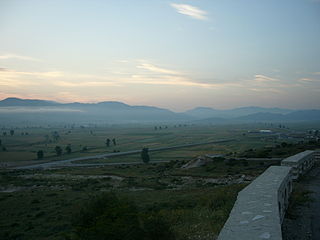
Dropull is a municipality in Gjirokastër County, in southern Albania. The region stretches from south of the city of Gjirokastër to the Greek–Albanian border, along the Drino river. The region's villages are part of the Greek "minority zone" recognized by the Albanian government, in which majorities of ethnic Greeks live.

The Monastery of the Nativity of the Theotokos in Ardenica (Albanian: Manastiri Lindja e Hyjlindëses Mari,; or simply Ardenica Monastery is an Albanian Orthodox monastery, located 18 kilometers south of Lushnjë, Albania, along the national road that links Lushnjë to Fier.

Hormovë is a community in Gjirokastër County, southern Albania. At the 2015 local government reform it became part of the municipality Tepelenë.
Saint Procopius Church of Tirana is an Orthodox church on the outskirts of Tirana, Albania. It was one of only two Orthodox churches that existed in the city before World War II, the other one being the 19th-century Evangelismos Church, which was demolished in 1967.

The Drino valley is a valley in southern Albania and northwestern Greece along the Drino river.
Dhuvjan is a settlement in the former Dropull i Poshtëm municipality, Gjirokastër County, southern Albania. At the 2015 local government reform it became part of the municipality Dropull. It is within the larger Dropull region.

Derviçan is a settlement in the former Dropull i Poshtëm municipality, Gjirokastër County, southern Albania. At the 2015 local government reform it became part of the municipality Dropull. It is within the larger Dropull region. The village is inhabited solely by Greeks.
Goranxi is a settlement in the former Dropull i Poshtëm municipality, Gjirokastër County, southern Albania. At the 2015 local government reform it became part of the municipality Dropull. It is within the larger Dropull region.
Holy Trinity Monastery Church is the katholikon of the monastery of the Holy Trinity in Pepel, Gjirokastër County, Albania. It is declared as a Cultural Monument of Albania.
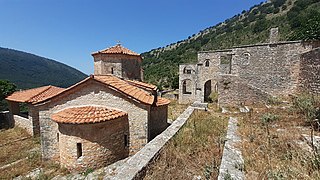
St. Mary's Monastery is an Albanian Orthodox monastery in Kakome, Vlorë County, Albania. It is a Cultural Monument of Albania.
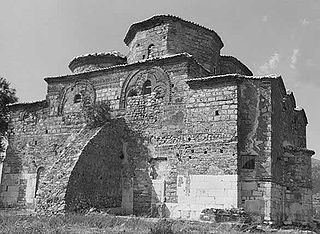
St. Nicholas Monastery Church is the katholikon of the abandoned Orthodox monastery of Saint George in Mesopotam, Vlorë County, Albania.
Dryinopolis or Dryinoupolis is a historical region in southwestern Albania and northwestern Greece in Epirus. The heartland of this region is the valley of the Drino river and Dropull/Dropolis. A Greek-Orthodox bishopric under this name was established at 449 AD as well as a theme (district) of the Byzantine Empire and the Despotate of Epirus. Today the name of Dryinopolis is preserved in the local metropolitan bishopric of the Church of Greece for the Greek part of the region, while the Albanian part is under the religious jurisdiction of the metropolis of Gjirokaster of the Autocephalous Orthodox Church of Albania.
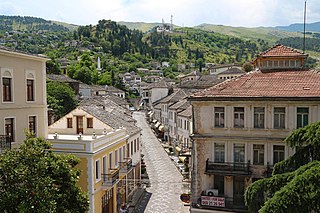
Gjirokastër is a city in southern Albania and the seat of Gjirokastër County and Gjirokastër Municipality. It is located in a valley between the Gjerë mountains and the Drino, at 300 metres above sea level. Its old town is a UNESCO World Heritage Site. The city is overlooked by Gjirokastër Fortress, where the Gjirokastër National Folk Festival is held every five years. It is the birthplace of former Albanian communist leader Enver Hoxha, and author Ismail Kadare.
Constantine of Berat, known among Albanians as Kostandin Jermonak Berati or shortly Kostë Berati, was an Albanian writer and translator of the 18th century.

The Agia Triada Monastery is a Greek Orthodox monastery dedicated to the Holy Trinity, on the southwestern slopes of Mount Olympus, Greece, near the village of Sparmos, whence it is also commonly known as Sparmou Monastery. Beside the monasteries Agios Dionysios and Kanalon it is one of the monasteries located at Mount Olympus.
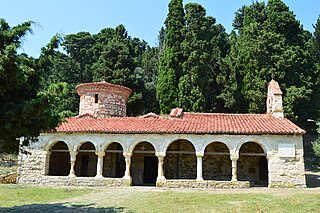
The St. Mary's Monastery, also known as the Monastery of Dormition of Theotokos Mary, , is a medieval Byzantine church in Zvërnec Island inside the Narta Lagoon northwest of the city of Vlorë of Southern Albania.
Monastery of Saint Vlash is a monastery of the Albanian Orthodox Church in village Shënavlash, Durrës District, Albania.











